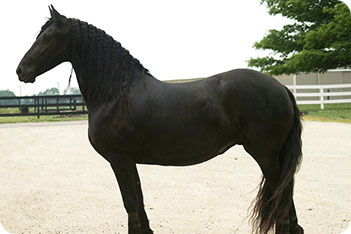

Horse Wounds
Horses are prone to injuring themselves and wounds such as cuts, grazes and puncture wounds are the most common.
Types Of Wounds
There are four main types of minor wounds, which in most cases will quickly heal if they are correctly managed with first aid.
If in any doubt contact your vet who will often be able to advise you over the phone or arrange a visit if further treatment is necessary.
- Laceration
A laceration is a cut or tear that is often deep with rough or jagged edges. Lacerations can occur from a barbed wire injury for example. - Incision
An incision is a thin cut or slice that can be caused from a bramble in the hedge. - Puncture
A puncture wound is one that penetrates or pierces some part of the horses body, such as when the horse treads upon a nail penetrating the sole of the hoof. - Graze
A skin graze is when the surface of the skin has been scraped or scratched away. This can occur if the horse scraps itself along a surface or gets kicked by another horse.
Prevention
Horses are experts at getting themselves into trouble, cuts and grazes frequently happen when horses are out together.
- Stables And Barns
Ensure that all areas your horse has access to are as safe as possible and do not contain any sharp edges or unsuitable fencing. - Field Management
When horses play they can often injure themselves, and careful management of horses that out together will need to examined if there is a particularly dominant horse causing several injuries. Regularly check the field for objects and protrusions. - Feeding Time
If there is a particularly stressful time when the horses become more dominant such as feeding time and become more aggressive towards other horses. - Travelling
Ensure that your horse trailer or lorry is safe inside with no sharp edges, has a sound floor and is roadworthy. When travelling make sure that your horse is wearing suitable and correctly fitting travel equipment such as rugs, boots or bandages and a leather headcollar.
Treatment
Many wounds are minor and heal up with some first aid however there are instances where they may need further veterinary treatment, so be prepared to call your vet if necessary.
- Laceration
The area should be thoroughly cleaned with an antiseptic wash and assessed to see if veterinary attention should be sought, such as if stitching s required. If appropriate allow the wound area to dry out a little and depending on the area either apply an antiseptic gel or spray or a dry dressing and bandage to cover the area over to protect it. - Incision
Incision wounds are often fairly quick to heal over and in most cases will require thorough cleaning with an antiseptic solution and cotton wool and then the application of a antiseptic cream, gel or spray. - Puncture Wound
A puncture wound can lead to serious complications if not treated properly as any infection can further infect bone and tissues and cause severe lameness. Common areas for puncture wounds include the sole of the hoof and the knee, although any area can potentially be punctured. Treatment will largely depend what are is punctured but the basic principle is to poultice to draw out any infection that may have entered the wound and to keep the e area clean and free from further contamination while the area heals.- The punctured area should be checked over to ensure that there is no object remaining inside the wound still and then thoroughly cleaned with an antiseptic wash such as hibiscrub.
- A wet and warm poultice that has been soaked in boiling water and left to cool a little is then placed over the wound site.
- This is then covered with a layer of veterinary gamgee, which will help provide insulation to the poultice and an extra protective layer of padding to keep the area clean.
- Using vetwrap bandage at the correct tension and in the case of a knee or hock bandage with the appropriate pressure relief points added in, secure the poultice and gamgee in place.
- If the puncture has occurred in the sole of the hoof then also apply a protective over boot which will help keep the bandages clean and less likely to be nibbled at.
- Grazes
Grazes can sometimes just take the hair off without breaking the skin in these cases there may be underlying bruising so if the area feels warm and is not broken then the application of arnica or a cooling gel can be beneficial.
If the skin is broken the clean the area with an antiseptic wash and then apply an antiseptic product.